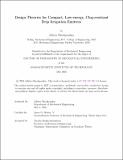Design Theories for Compact, Low-energy, Clog-resistant Drip Irrigation Emitters
Author(s)
Ghodgaonkar, Aditya
DownloadThesis PDF (113.3Mb)
Advisor
Winter V, Amos G.
Terms of use
Metadata
Show full item recordAbstract
This thesis presents the derivation, experimental validation, and demonstration of new design theories for compact, low-pressure, clog-resistant drip emitters that can make drip irrigation affordable, reliable, and easier for farmers to adopt. Broad adoption of water-efficient irrigation methods such as drip irrigation is imperative to sustainably meet projected global food demand against the backdrop of diminishing freshwater resources, constrained arable land, and climate change. In drip irrigation systems, emitters are passive flow-regulating devices that are inserted into the drip tube to align with every plant. They are designed to provide a constant flow rate once they are pressurized to at least their activation pressure, thus ensuring uniform, localized irrigation of plants. However, conventional emitters directly contribute to three barriers that have limited drip irrigation adoption – high raw material-driven equipment costs, high pumping power costs associated with pressurizing all emitters in the field to their activation pressure, and gradual loss of reliability due to clogging. Compact, low-pressure, clog-resistant emitters can address these challenges, but to design them, we must model and tune their operating physics, which is centered around two complex features – a millimeter-scale tortuous passage called the labyrinth, and fluid-structure interaction (FSI) involving a flexible silicone rubber diaphragm and a micro-duct. This makes conventional design approaches relying on high-fidelity simulation software or empirical trial-and-error too expensive and time-consuming to use for the development of compact, low-pressure, clog-resistant emitters on competitive industrial timelines. This thesis addresses these challenges through three contributions.
The first contribution presents an empirically derived hydraulic model of emitter labyrinths, which are typically the most volume-intensive feature of emitters. The model relates labyrinth flow rate to select material volume agnostic parameters, allowing designers to create compact labyrinths with desired hydraulic performance. The compact labyrinths can enable up to 10% reduction in the raw material-driven cost of drip equipment.
The second contribution presents a 1-dimensional model of the FSI in emitters that can predict their flow rate-pressure performance in 2-3 minutes and within 8-14% error, cutting down on design cycle times by orders of magnitude. This facilitated the rapid synthesis of low-pressure emitter designs having 50-60% less activation pressure than conventional emitters, cutting pumping power costs by an estimated 18-23%.
Together, the first two contributions can enable an estimated 18% reduction in the lifetime costs of drip irrigation, but long-term adoption requires that the emitters be clog-resistant and compatible with the current maintenance practices of farmers. To that end, the third contribution presents an experimental investigation of clogging in low-pressure emitters. The results of the investigation directly correlated the geometry of emitter hydraulic features to the critical particle size that would clog them. As a result, compact, low-pressure emitters could be designed to be compatible with the same filters and maintenance practices as current state-of-the-art products that have higher activation pressures. This was confirmed by field testing the compact, low-pressure, clog-resistant (MIT) emitters alongside commercial reference designs with their prescribed filters for nearly 1200 hours. At the end of the field test, the MIT emitters still held 90-94% of their initial flow rate, putting them on par with or better than the reference products in terms of irrigation reliability. The collective contributions of this thesis present the knowledge needed to design emitters that can make drip irrigation more affordable to adopt by farmers and demonstrate that substantial capital and operating cost reductions can be realized without sacrificing product reliability or requiring expensive changes to current farmer maintenance practices.
Date issued
2025-05Department
Massachusetts Institute of Technology. Department of Mechanical EngineeringPublisher
Massachusetts Institute of Technology